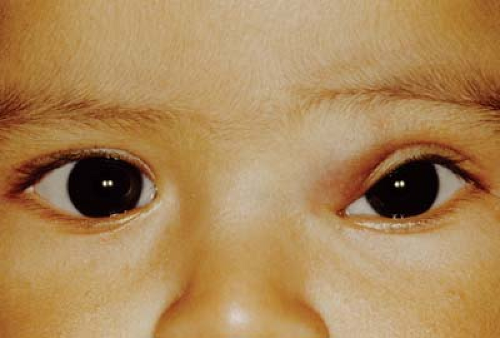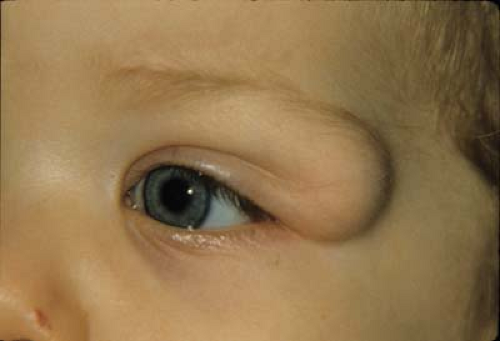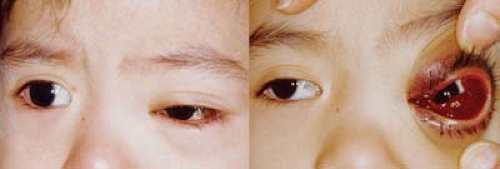Orbit
Alex V. Levin
Thomas W. Wilson
Dan DeAngelis
Robert Pashby
Jeffrey Hurwitz
The orbit contains multiple tissues, each of which is subject to disease. A disease process in any tissue may have contiguous effects on neighboring tissues within this closed and compact compartment, in particular the optic nerve. Compression, stretching, or ischemia of the optic nerve will lead to rapid visual field and/or vision loss, which may or may not be irreversible. Tumor of virtually any orbital tissue can cause optic nerve compression. Likewise, hemorrhage, infiltration, infection, or vascular malformation may cause optic nerve compression. In the latter, if there is a lymphangiomatous component, compression may only occur when infection, for example, an upper respiratory viral systemic infection, results in temporary swelling of the orbital lesion. Tumors of the optic nerve itself are covered in Chapter 9: Optic Nerve.
Proptosis occurs when there is an increase in retrobulbar orbital volume. This can be acute or chronic. It may result from a variety of benign and malignant lesions. Benign tumors include vascular malformations and cysts. Orbital malignancy may be local (e.g., rhabdomyosarcoma, optic nerve glioma) or systemic (e.g., leukemia, neuroblastoma). Infectious causes of proptosis may also be acute (e.g., bacterial orbital cellulitis) or chronic (e.g., parasitic cyst). Acute inflammatory disease includes pseudotumor. As the globe translates forward for any reason, the optic nerve is stretched, resulting in serious vision loss. Surgical decompression of the orbit may be needed.
 Figure 11.3 Capillary Hemangioma Capillary hemangiomas commonly occur on the lids and anterior orbit. Clinically, they range from small isolated lesions to larger tumors that can cause ptosis (as seen in this child’s left medial upper lid) and visual loss. There may or may not be an overlying “strawberry” lesion (Chapter 2: Lids and Adnexa, Figs. 2.17 and 2.18). Systemic considerations include the Kasabach-Merritt syndrome, a consumption coagulopathy associated with large hemangiomas. The natural history involves a proliferative phase in the first year of life followed by regression. Indications for treatment include amblyopia, proptosis, and optic neuropathy. Intralesional steroids are not recommended for deep lesions like the one shown here. Other treatment options include surgical excision, systemic steroids, or interferon.
Stay updated, free articles. Join our Telegram channel
Full access? Get Clinical Tree
 Get Clinical Tree app for offline access
Get Clinical Tree app for offline access

|

